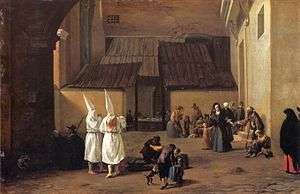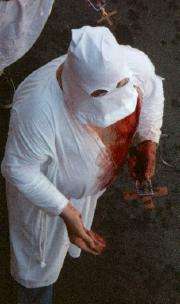Flagellant
Flagellants are practitioners of an extreme form of mortification of their own flesh by whipping it with various instruments. Most notably, Flagellantism was a 14th-century movement, consisting of radicals in the Catholic Church. It began as a militant pilgrimage and was later condemned by the Catholic Church as heretical. The followers were noted for including public flagellation in their rituals. This was a common practice during the Black Death, or the Great Plague.
.jpg)
History
_%C2%B7_HHWXI26.svg.png)
Flagellation (from Latin flagellare, to whip) was quite a common practice amongst the more fervently religious throughout antiquity.
Following the example of the Benedictine monk Peter Damian in the 11th century, flagellation became a form of penance in the Catholic Church and its monastic orders. The 11th-century zealot Dominicus Loricatus repeated the entire Psalter twenty times in one week, accompanying each psalm with a hundred lash-strokes to his back. The distinction of the Flagellants was to take this self-mortification into the cities and other public spaces as a demonstration of piety.
Spread in the 14th century
The first recorded incident was in Central Italy in Perugia, in 1259, the year after severe crop damage and famine throughout Europe. From Perugia the phenomenon seemed to spread across Northern Italy and into Austria. Other incidents are recorded in 1296, 1333-34 (the Doves), notably at the time of the Black Death (1349), and 1399. The practice peaked during the Black Death. Spontaneously Flagellant groups arose across Northern and Central Europe in 1349, including in England.[1] However, enthusiasm for the movement diminished as suddenly as it arose. When they preached that mere participation in their processions cleaned sins, the Pope banned the movement in January 1261.
Initially the Catholic Church tolerated the Flagellants and individual monks and priests joined in the early movements. By the 14th century, the Church was less tolerant and the rapid spread of the movement was alarming. Clement VI officially condemned them in a bull of October 20, 1349 and instructed Church leaders to suppress the Flagellants. This position was reinforced in 1372 by Gregory XI who associated the Flagellants with other heretical groups, notably the Beghards. They were accused of heresies including doubting the need for the sacraments, denying ordinary ecclesiastical jurisdiction and claiming to work miracles.[2]
The Inquisition was active against any revival of the movement in the 15th century, but action against the flagellants was often taken by the local princes. In 1414, 80–90 followers of Konrad Schmid were burned in Thuringia, in Germany, even though they had recanted.[3] Three hundred were burnt in one day in 1416, also in Thuringia.[3] Other trials where the accused were condemned as Flagellants were recorded as late as the 1480s.[4] The practice of flagellation within the bounds of the Catholic Church continued as an accepted form of penance.
Rulers like Catherine de' Medici and France's King Henry III supported Flagellants but Henry IV banned them. Flagellant orders like Hermanos Penitentes (Spanish 'Penitential Brothers') also appeared in colonial Spanish America, even against the specific orders of Church authorities.
In Italy
The first recorded cases of mass popular flagellation occurred in Perugia, in 1259. The prime cause of the Perugia episode is unclear, but it followed an outbreak of an epidemic and chroniclers report how mania spread throughout almost all the people of the city. Thousands of citizens gathered in great processions, singing and with crosses and banners, they marched throughout the city whipping themselves. It is reported that surprising acts of charity and repentance accompanied the marchers. However, one chronicler noted that anyone who did not join in the flagellation was accused of being in league with the devil. They also killed Jews and priests who opposed them. Marvin Harris[5] links them to the Messianic preaching of Gioacchino da Fiore.
Similar processions occurred across Northern Italy, with groups up to 10,000 strong processing in Modena, Bologna, Reggio and Parma. Although certain city authorities refused the Flagellant processions entry.
A similar movement arose again in 1399, again in Northern Italy in the form of the White Penitents or Bianchi movement. This rising is said to have been started by a peasant who saw a vision. The movement became known as the laudesi from their constant hymn singing. At its peak, a group of over 15,000 adherents gathered in Modena and marched to Rome, but the movement rapidly faded when one of its leaders was burned at the stake by order of Boniface IX.
In Germany

The German and Low Countries movement, the Brothers of the Cross, is particularly well documented - they wore white robes and marched across Germany in 33.5 day campaigns (each day referred to a year of Jesus's earthly life) of penance, only stopping in any one place for no more than a day. They established their camps in fields near towns and held their rituals twice a day. The ritual began with the reading of a letter, claimed to have been delivered by an angel and justifying the Flagellants' activities. Next, the followers would fall to their knees and scourge themselves, gesturing with their free hands to indicate their sin and striking themselves rhythmically to songs, known as Geisslerlieder, until blood flowed. Sometimes the blood was soaked up in rags and treated as a holy relic. Originally members were required to receive permission to join from their spouses and to prove that they could pay for their food. However, some towns began to notice that sometimes Flagellants brought plague to towns where it had not yet surfaced. Therefore, later they were denied entry. They responded with increased physical penance.
In Germany they claimed they could resurrect emperor Frederick II, who would bring an age of social justice.
Modern flagellants

Roman Catholic
Modern processions of hooded Flagellants are still a feature of various Mediterranean Catholic countries, mainly in Spain, Italy and some former colonies, usually every year during Lent. They also occur in the Philippines during Holy Week. For example, in the commune of Guardia Sanframondi in Campania, Italy, such parades are organized once every seven years. In Italy, members of the Flagellant movement were called disciplinati, while laudesi never practiced flagellation, but met together in their own chapel to sing laudi (canticles) in honour of the Blessed Virgin, but which gradually assumed a dramatic form and grew into a theatrical form known as rappresentazioni sacre. A play in the Roman dialect of the 14th century, edited by Vattasso (Studi e Testi, no. 4, p. 53), explicitly bears the title lauda.
Some Roman Catholics in Philippines practice flagellation as a form of devout worship, sometimes in addition to self-crucifixion.[6][7]
Los hermanos penitentes
In English, "the penitent brothers." This is a semi-secret society of flagellants among the Hispanic Roman Catholics of Colorado and New Mexico.CATHOLIC ENCYCLOPEDIA: Los Hermanos Penitentes
Other religions
Unrelated practices exist in non-Roman Catholic traditions, including actual flagellation amongst some Shiites (commemorating the martyrdom of Husayn ibn Ali).
See also
- Algolagnia
- Ashura, Tatbir
- Dancing mania
- Flagellation
- Monty Python and the Holy Grail, which includes a scene of monks striking themselves on the forehead repeatedly with boards while chanting the missal passage Pie Jesu.
- Penitentes (New Mexico)
- Self-harm
- The Seventh Seal
- Redemptive suffering
- La Cercha
References
- Lewis-Stempel, John (2006). England : the autobiography : 2,000 years of English history by those who saw it happen. London: Penguin. p. 76. ISBN 9780141019956.
Flagellants Come To London, Michaelmas 1349. Robert of Avesbury.
- Cohn, Norma. The Pursuit of the Millennium: Revolutionary Millenarians and Mystical Anarchists of the Middle Ages Oxford University Press, Ch. 7 ISBN 0-19-500456-6
- Cohn, Norman (1970). The Pursuit of the Millennium: Revolutionary Millenarians and Mystical Anarchists of the Middle Ages. Oxford University Press. p. 146. ISBN 0198020023. Retrieved 12 June 2018.
- Cohn (1970), p. 147
- Marvin Harris, Cows, Pigs, Wars and Witches, Chapter 10 .
- "Men Crucify Themselves in Philippines". Newser. Retrieved 2014-06-16. (during the end of Lent season).
- "Filipino devotees re-enact crucifixion of Christ". Yahoo News. Retrieved 2014-06-16.
External links
| Wikimedia Commons has media related to Flagellation. |
- . Catholic Encyclopedia. 1913.
- . Encyclopædia Britannica (11th ed.). 1911.